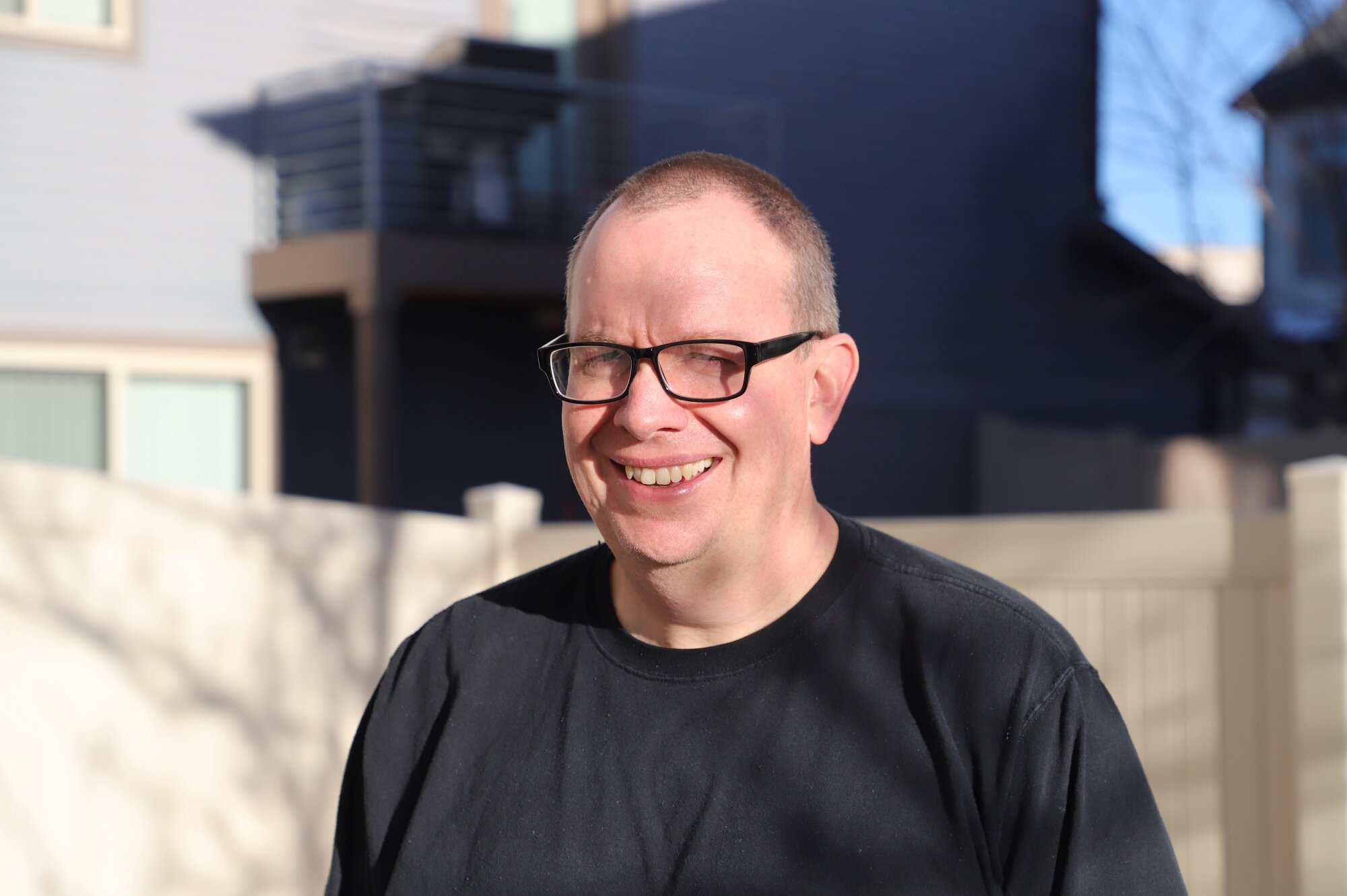'The Inside Report' may have published its final issue, but prisoners are still writing

DENVER — Bob Eisenman wore green when he proposed to his partner. The future bride wore yellow. Both of them were in prison uniforms.
The couple was incarcerated at the time — Eisenman at Fremont Correctional Facility in Florence and his partner at La Vista Correctional Facility in Pueblo. They fell in love while working together, over Zoom, on The Inside Report, a newspaper produced by Colorado prisoners, for Colorado prisoners.
“Prison is one of the most repressive environments you can imagine. It’s terrible,” Eisenman said. Working for the paper — and meeting his future wife — saved him.
“Talk about night and day, in terms of how to do prison time,” he said. “It’s a completely different experience. Just the whole vibe of the prison is different. You get so used to not being treated like a human and then all of a sudden, here’s these people — all these artists coming from the outside — being like, ‘No, you have value.’”
The Inside Report, like the radio program Inside Wire, was the result of a partnership between the Colorado Department of Corrections (CDOC) and the University of Denver Prison Arts Initiative (DUPAI).
The contract between CDOC and DUPAI expired in August of last year after three years of successful programming and national recognition. Neither party has explained why the contract was not renewed. Regardless, the end of the contract resulted in the end of DUPAI’s arts offerings.
The Inside Report and Inside Wire shuttered as a result, much to the surprise of prisoners like Eisenman.
“We were getting ready to go to print with one of our special issues,” said Eisenman, who worked his way up from copy editor to writer development coordinator at the paper. “We were ready to go, and it was literally like an overnight thing — we were finalizing the product on a Thursday and then Friday we were [told], ‘You're not allowed to go in the newsroom.’”

A column from Eisenman featured in the Spring 2023 issue of The Inside Report.
Photo: Kyle Cooke, Rocky Mountain PBS
CDOC public information officer Alondra Gonzalez told Rocky Mountain PBS “there have been no new developments since the initial contract expired.”
In an email, Lilly Stannard, the assistant director of programming for DUPAI, said “unfortunately we still aren’t on the other side and in a place to speak publicly.”
The Inside Report’s main newsroom was in Fremont, where Eisenman spent most of his sentence. He made about $50 each month for his work as writer development coordinator — “huge money,” he said, considering most prisoners make about 78 cents a day.
The final copies of The Inside Report never saw the light of day. At least, not officially.
“You know, it's prison,” Eisenman said with a smile. “We've been able to smuggle a few to people.”
The final authorized issue of The Inside Report was the Winter 2023 edition, which you can read here.
Eisenman had five bylines in the last edition. His stories included a piece about the brutality of the job market for formerly incarcerated people and an article about The Inside Report’s refurbished newsroom.
Eisenman was in prison for about 15 and a half years. He was released November 28, 2023. Today, he lives in Denver’s Central Park neighborhood in a home with other parolees. He enjoys cooking for his roommates, and in between applying for jobs, he eagerly awaits the opportunity to grow vegetables in his modest backyard.
For the final five months of his sentence, Eisenman was not allowed to work on The Inside Report, or to enter the newsroom where he had logged at least 40 hours a week for the previous three years.
“Everybody does time differently, but for the most part everybody likes a routine,” Eisenman said. “And at that point they were like, ‘Okay, you're not allowed to go work.’ And then they're [CDOC] so short staffed, you're not allowed to go to yard because they don't have staff to cover the yard. So you sit around and, you know, do nothing.”
“Although DUPAI is no longer running we still have other great programs running within the department,” Gonzalez with CDOC said. However, the department no longer offers any prison media programs.

Bob Eisenman was a prolific writer and mentor for The Inside Report since its inception. Now living in Denver, he is inspired by the prisoners who are still working to share their stories.
Photo: Kyle Cooke, Rocky Mountain PBS
Prison journalism is nearly as old as the United States. On March 24, 1800 — just 23 years after the Founding Fathers signed the Declaration of Independence — prisoners in a New York state penitentiary published Forlorn Hope, the first prison newspaper in America.
More than 450 prison newspapers followed in the ensuing centuries, resulting in first-person reports and accountability journalism within a historically nontransparent corrections system.
As the journalist and filmmaker Olivia Heffernan noted in Jacobin, prison media has social benefits, too.
“Prison journalism is a medium through which incarcerated writers are able to express themselves,” Heffernan wrote.
There are rehabilitative benefits as well. For example, none of the men who have worked for the San Quentin News in the San Quentin Rehabilitation Center — California’s oldest prison — have returned to prison, according to the book “Prison Truth” by William Drummond, who served as an advisor for the paper.
“The rehabilitative potential of the newsroom is, for some, far more important than their role in stoking a conversation around reform,” wrote reporter Emily Nonko about the San Quentin News for Politico.
[Related: San Quentin’s Breakthrough Prison Newsroom]
Few people are more attuned to the rehabilitative effects of prison media than Veronica Pinnecoose. She always made sure to grab a copy of The Inside Report when she visited Fremont Correctional Facility, where her son Daniel is incarcerated.
Daniel has been in prison since 2015. Before prison, “he was not artistic,” his mom said. “Not at all… it just really changed when he first started getting involved.”
Pinnecoose, who lives in Ignacio — more than 250 miles from Fremont — talks to her son every day unless the prison is on lockdown. But the 20 minute phone calls pass quickly, which is why she was excited when Daniel became involved in programs that she too could engage in, like The Inside Report.
For families on the outside, she explained, these programs offered another way to connect with their incarcerated loved ones. Daniel, meanwhile, was perpetually busy.
“Any program they had, he got involved,” she said. That included creative writing, dance and even a production of “Godspell,” where he worked as a costume designer. Later, he joined The Inside Report as a reporter.
“It just gave [prisoners] purpose,” Veronica said of the DUPAI programs. “They became people. I heard that a lot — ‘We’re finally being treated like people. They call us by our names. They are kind to us and we have value.’”
When DUPAI ended, Pinnecoose said there was “grumbling” within the prisons. “Like, ‘man, you know, this is something else they took away from us. And now we lost everything,’” she said.
That feeling of defeat, however, was short-lived.
“Daniel said, ‘no, if we give it up now, it’s because we surrendered it,’” Pinnecoose said. Daniel immediately began putting together curriculums for classes that he could teach without DUPAI support, including a crochet class.
“They planted a seed and it changed his life,” Pinnecoose said of DUPAI. “I'm thrilled with what they did for my son. He just ignited a passion in him that none of us expected.”
Eisenman described people like Daniel as part of a “pocket resistance.”
“There's guys teaching painting classes or crochet classes or writing classes and poetry classes,” Esisenman said. “They have guys who took those classes that are lifers, that will never get out. And they're not going to stop doing this, which has been really inspiring for me to hear.”
“And they're still in there writing stories,” he said. “They're just not getting published.”
Kyle Cooke is the digital media manager for Rocky Mountain PBS. Kylecooke@rmpbs.org.